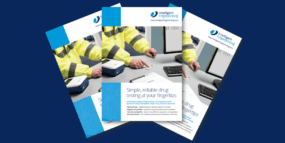Transport Operator: Drug screening for 21st century transport, written by Dr Paul Yates
12.12.2016

Dr Paul Yates, business development director at Intelligent Fingerprinting, examines how the advent of fingerprint-based testing technology could help tackle drug-driving.
Drug driving was thrown into the spotlight in the UK when new legislation was introduced inMarch 2015, making it unlawful to drive with eight illegal drugs and eight prescription drugs in the body above a specified level.
As a result, police officers can use a Home Office—approved ‘drugalyser’ to screen for cannabis and cocaine at the roadside, and screen for other illegal drugs, including ecstasy, LSD, ketamine and heroin, at the police station.
Since the legislation came into being, half of drivers stopped for suspected drug driving have tested positive, leading to 7,796 arrests for drug driving in England and Wales between March 2015 and April 2016.
Drivers who consume cannabis, the most commonly used illegal drug among UK adults, are two to six times more likely to have a road traffic collision than those who don’t and, if combined with alcohol, that risk rises to 16 times.
Amphetamines and methamphetamines may not be as widely used as cannabis, but the risk of a collision following consumption is higher than either cannabis or cocaine. In Great Britain it is estimated that drug driving accounts for up to 200 deaths every year.
Transport operators need to take action to minimise risk and safeguard themselves, their workforce and the general public against drug driving by their employees.
In an effort to deter employee drug use, many transport companies have introduced
drug and alcohol policies, including screening protocols and procedures. These policies form part of an employee’s obligations.
An active policy which discourages drug use by employees and identifies potential issues early can be invaluable. However, a 2014 report from road safety charity Brake showed that more than half (57 per cent) of employers with staff that drive for work do not test for drugs.
In many cases, workplace drug screening policies apply to all employees, but more typically it is employees in safety—critical roles such as drivers who are subject to drug testing.
Screening can take place as part of pre—employment checks, after an accident or with reasonable suspicion of drug use, or randomly. According to the Brake report, the most common form of screening is random testing, used by 29 percent of employers.
The most widely used drug screening methods to provide evidence of recent drug use involve analysis of urine, oral fluid (saliva) or, less commonly blood samples. Of these methods urine is the most widely used by fleet providers.
Current drug screening methods have their limitations. Collection of invasive body fluids for drug testing is costly, time—consuming and difficult to administer on—site because of the need to set up specially prepared collection areas and provide trained, often gender— specific, collectors on site as well as specialist waste disposal facilities.
Intelligent Fingerprinting is developing what is thought to be the world’s first portable, fingerprint—based drug screening system. The system works by analysing fingerprint sweat to
detect drug metabolites, which are chemicals produced by the body when it processes
(metabolises) drugs of abuse.
The new drug screen requires the collection of a single fingerprint sample for analysis and detection of up to four drugs of abuse in one test. Collection of the fingerprint sample onto the test cartridge takes a few seconds and the cartridge is then inserted into a reader.
The reader analyses the fingerprint sweat for drug metabolites, providing a positive or negative result in less than 10 minutes and giving a simple pass or fail reading against pre—determined drug screening cut—off levels. The device automatically measures drug concentration against these
cut—offs without the need for the operator to read test strip results or similar.
As the reader is portable, samples can be collected on—site for on—the—spot fitness for duty tests. Unlike body fluid drug screening, the test is completely non—invasive and presents no biohazard risk, so there is no need for specialist collection or sample disposal facilities.
The unique fingerprint—based drug screen is quick and easy to use, and fully portable.
These benefits could result in an overall improvement in the effectiveness of the drug policies of fleet providers, in particular allowing truly random tests that discourage drug use whilst reducing the costs associated with the implementation of conventional body fluid drug screening solutions.
While drug—driving conviction rates hit the headlines and awareness of the prevalence of drug—driving continues to grow, many transport operators will no doubt be reviewing their HR processes to ensure their employee drug and alcohol policies are fit for purpose.
New emerging technologies such as the Intelligent Fingerprinting drug screening system can help to respect an employee’s requirements for privacy and dignity, while protecting their colleagues and
ensuring public safety.
Download pdf: Transport Operator Feature (By kind permission of Transport Operator.)



